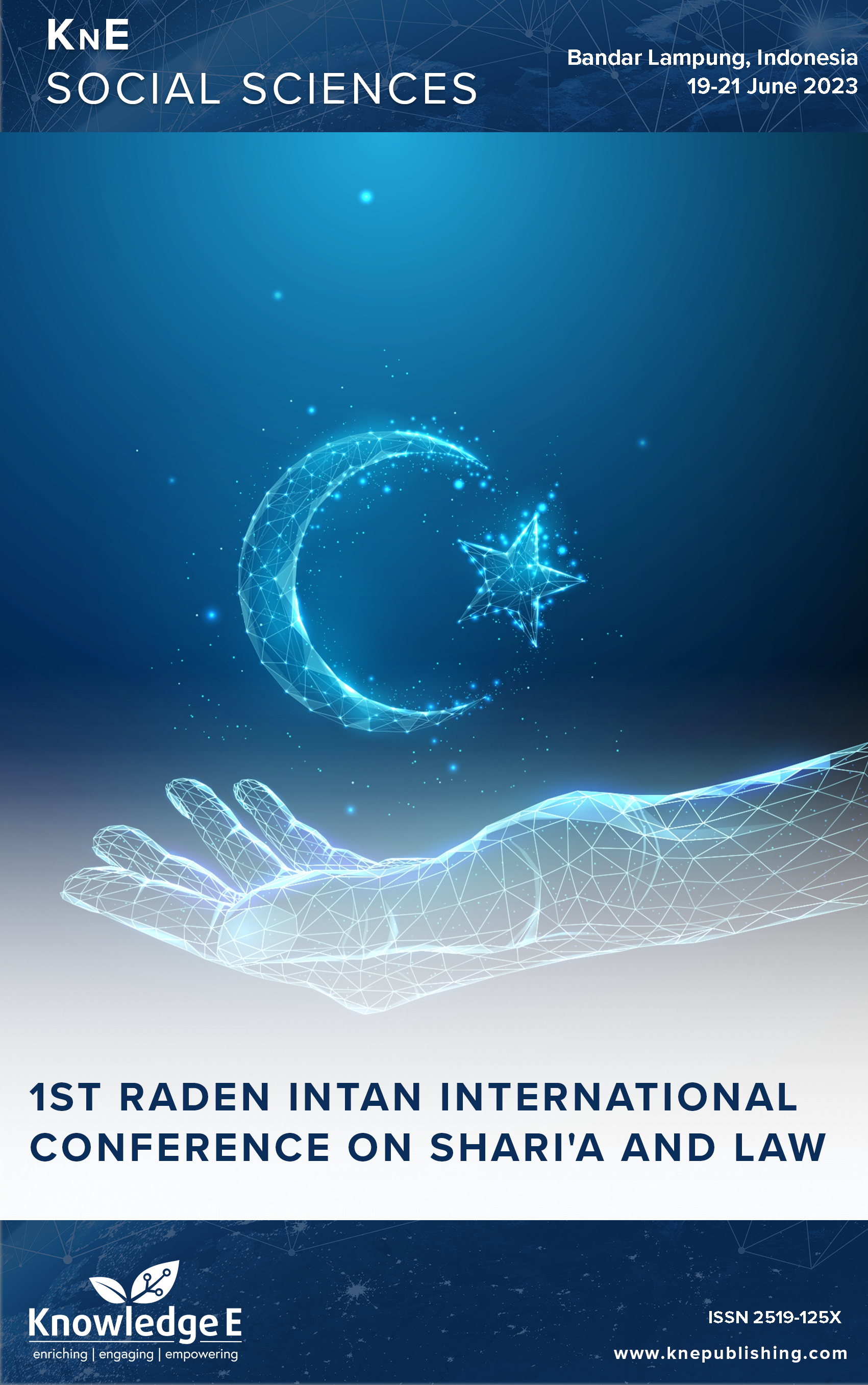Islam and Society 5.0 Era: Privacy between Husband and Wife in Review of Family Law Interpretation
DOI:
https://doi.org/10.18502/kss.v9i1.14994Abstract
This paper examines the privacy between husband and wife in a marital relationship from the perspective of Islamic family law interpretation. This study aims to reveal the explanation of the Qur’an as the main source of Islamic law in privacy issues between husband and wife, especially in this social era 5.0. The method used in obtaining data is qualitative through literature studies, further analyzed by the content analysis method. The results of the study show that according to the perspective of the Qur’an, there is no longer any privacy between husband and wife. This is based on the interpretation of several verses, namely QS. al-Nisa’ [4]: 21 and 34, QS. al-Rum [30]: 21, and QS. al-Baqarah [2]: 187. Everything shows that the husband and wife are two people who have no privacy with each other. Thus, in this social era 5.0 where home life cannot be separated from technology, such as gadgets, smartphones, mobile phones, laptops, and so on, in which some things are private, such as communication, social media, mobile banking, and so on, then for husband and wife, this is not included in the category of privacy between each other (Accessing it does not fall under the nusyuz category). Thus, it is not worthy and inappropriate to be kept secret from the couple. In fact, keeping it secret seems like there is a problem and is an aberration.
Keywords: husband and wife, privacy, Society 5.0 Era
References
Chairani N. “Family- do you need conjugal privacy?” Republika, Tuesday 26 Jan Retrieved Monday, June 19, Look, https://www.republika.co.id/berita/o1jkg79/keluarga-perlukah-privasi-suamiistri
Bagaskara B. “The culprit of divorce in the eyes of jack’s infidelity detective”. detikjabar, Saturday, May 20, Learn more https://www.detik.com/jabar/berita/d- 6729329/biang-kerok-perceraian-di-mata-jacks-detektif-perselingkuhan
Bojonegoro RC. 1A, “Online infidelity rampant divorce rate in Bojonegoro Increases.” Article, Mar 07, Learn more https://wartaku.id/hukum/marak-perselingkuhan-onlineangka- perceraian-di-bojonegoro-meningkat/
Islamy IT. The importance of understanding the application of privacy in the information technology era. J Inf Technol Educ. 2018 Sep;11(2):21–
Sukandar, et al. The Practice of Mbangun Nikah with Abajadun Count at Kedung Bengkah Islamic Boarding School Sukomoro Nganjukper Islamic Law Perspective. KLASULA: Journal of Administrative and Criminal Constitutional Law. 2022 Apr;1(1):49– DOI: https://doi.org/10.32503/klausula.v1i1.2365
Kusnadi SA, Wijaya AU. Legal protection of personal data as a right to privacy. Al WASATH Journal of Legal Sciences. 2021 Apr;2(1):9–
Anwar Nawawi M. Women’s right to privacy in Iddah: A study between Islamic normatitivity and human rights. Court Journal. 2019 Jun;4(1):83–
Pramesthi JA, et al. Communication privacy management: A literature study on privacy boundaries in the Indonesian family context. Journal of Communication Domain, VOL. 2020;4(2):122–
Latumahina RE. Legal aspects of personal data protection in cyberspace. Journal of GEMA AKTUALITA. 2014;3(2):14–
Dewi. “Principles of personal data protection of credit card customers according to national provisions and their implementation”, Sociohumanities, Vol. 19 No. 3 of 2017, 206 –
Yuniarti, S. 2019, “Perlindungan Hukum Data Pribadi di Indonesia”, Jurnal Becoss. 2019;1(1):147- https://doi.org/21512/becossjournal.v1i DOI: https://doi.org/10.21512/becossjournal.v1i1.6030
Muhammad ibn Mukrim ibn Ali Abu al-Fadhl Jamaluddin Ibn Manzhur Al-Anshari, Lisan Al-Arab, 3rd cet., (Beirut: Dar Shadir, t.th), 4425
Ibn Jarir al-Thabari, Tafsir al-Thabari, ( Jakarta: Pustaka Azzam. Juz. 2008;8:
Moh. Subhan, “Rethinking the Nusyuz concept of relations creating harmonization in the family”. Al-’Adalah. Journal of Sharia and Islamic Law. 2019 Dec;4(2): DOI: https://doi.org/10.31538/adlh.v4i2.542
Salam N. “The concept of Nusyuz in Quranic perspective (A Study of Tafsir Maudhu’i)”, de Jure. Journal of Sharia and Law. 2015 Jun;7(1): DOI: https://doi.org/10.18860/j-fsh.v7i1.3511
Ayu RF, Pangestu R. Nusyuz Modernity: Between Rights and Domestic Violence. Yudisia : Journal of Legal Thought and Islamic Law. 2021 Jun;12(1):79– DOI: https://doi.org/10.21043/yudisia.v12i1.8711
Complete Marriage Rules, Laws, and Laws in Indonesia. Yogyakarta: Rona Pancaran Ilmu; p.
Septi Aji Fitra Jaya. “The Qur’an and Hadith as the Source of Islamic Law”, Indo- Islamika, Volume 9, No. 2 July-December 2019/1440,
Sukandar, et al., “The Practice of Mbangun Nikah...”, 50-
Muhammad Mutawally al-Sha’rawy, Tafsir al-Sha’rawy (Egyptian: Akhyar al-Yaum, t.th) Volume 18,
Muhammad al-Thahir Ibn ’Assyria, Tafsir al-Tahrir wa al-Tanwir (Tunisian: al-Dar al- Tunisiah, 1984), vols. 21, 71
Fakhr al-Din al-Razy, Mafatih al-Ghaib (Beirut: Dar al-Kutub al-’Ilmiyyah, 2000), Juz 9, 374
Mutawally al-Sya’rawy, Tafsir al-Sya’rawy, 360
‘Imad al-Din Abu al-Fida’ Isma’il ibn Kathir al-Dimasyqy, Tafsir al-Qur’an al-’Azhim, (Cairo. Mu’assasat Qurthubah. 2000;2:
Muhammad Mutawally al-Sya’rawy, Tafsir al-Sya’rawy,
Muhammad Mutawally al-Sya’rawy, Tafsir al-Sya’rawy,
Sayyid Muhammad Rashid Ridha, Tafsir al-Qur’an al-Hakim/Tafsir al-Manar (Egypt: al-Manar Publishers, 1350 AH), Volume 2, 176
Muhammad Shahrur, al-Kitab wa al-Qur’an Qira’ah Mu’ashirah (Damascus: al-Ahaly, t.th),
Wahbah al-Zuhaili, al-Tafsir al-Munir fi al-’Aqidah wa al-Syari’ah wa al-Manhaj (Damascus: Dar al-Fikr, 2009), Volume 1,
Wahbah al-Zuhaili, al-Tafsir al-Munir fi al-’Aqidah wa al-Syari’ah wa al-Manhaj (Damascus: Dar al-Fikr, 2009), Volume 1, 514
Ahmad Mushthafa al-Maraghi, Tafsir al-Maraghi (Egypt: Publisher Mushthafa al-Baby al-Halaby wa Awladih. Juz. 1946;2:
Ahmad Mushthafa al-Maraghi, Tafsir al-Maraghi (Egypt: Publisher Mushthafa al-Baby al-Halaby wa Awladih. Juz. 1946;2:
Muhammad ’Izzat Darwazah, al-Tafsir al-Hadits Tartib al-Suwar Hasab al-Nuzul, Cet. II (), Juz 6,
Sayyid Muhammad Husein al-Thabathaba’I, al-Mizan fi Tafsir al-Qur’an (Beirut: Mu’assasat al-A’lami li al-Mathbu’at, 1997), Juz 2, 45-

